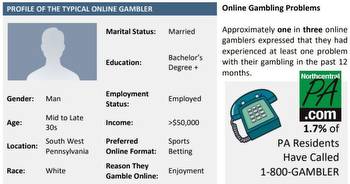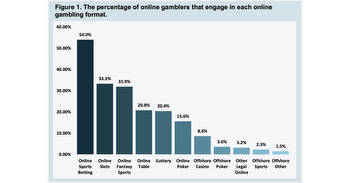Gambling participation continues to increase in Pennsylvania, researchers report

UNIVERSITY PARK, Pa. — Online and offline gambling has continued increasing rapidly in Pennsylvania since its legalization in 2017, according to the latest Pennsylvania Interactive Gaming Assessment: Online Gambling Report 2023. The report, which summarizes three years of survey data from more than 1,800 individuals from across the commonwealth, was developed by Penn State’s Criminal Justice Research Center under contract with the Pennsylvania Department of Drug and Alcohol Programs (DDAP).
The researchers found online gambling participation increased to 16% in 2023 after holding steady at 11% in 2021 and 2022. Additionally, Pennsylvania’s online gambling revenue in 2023 was more than $2.1 billion — a nearly 27% increase over the preceding year. Its popularity places the state among the top three online gambling revenue-generators in the nation.
The researchers also found that approximately half of Pennsylvania online gamblers reported problems with gambling. Increases in gambling frequency, hours, number of formats, spending and motivation to relieve stress were all factors associated with gambling problems.
“As we see increased revenue and advertising for online gambling, this report serves as a way for the Commonwealth of Pennsylvania to understand the potential impacts on individuals, families and communities,” said Glenn Sterner, assistant professor of criminal justice at Penn State Abington, lead author of the report and Social Science Research Institute co-funded faculty member. “We remain committed to monitoring problem gambling and other issues that may result from greater access to online gambling.”
Other findings of the report revealed:
- Those that gamble both offline and online — called dual-mode — gambled once a week while offline-exclusive gamblers played two to three times per month.
- Dual-mode gamblers spent almost 15 hours per month gambling, while offline gamblers spent about 1.5 hours per month gambling.
- On average, gambling expenses per month were higher among dual-mode gamblers at $708 versus offline gamblers at $103.
- About one-quarter of dual-mode gamblers earned less than $50,000 annually, and these individuals engaged in the highest number of gambling formats.
- The average age of dual-mode gamblers was 37 with the majority having earned a bachelor’s degree and being currently employed.
- Sports bettingwas the most popular online gambling format.
“Being aware of the current online gambling trends in Pennsylvania will help DDAP in its mission to assess and address how gambling behaviors impact compulsive and problem gambling within the commonwealth,” said DDAP Secretary Latika Davis-Jones. “It will also help us to spread awareness that treatment and resources, like the 1-800-GAMBLER helpline, are there when someone needs help.”
Since this evidence indicates that problematic gambling behaviors are seemingly highest among those who gamble online — whether exclusively or also offline — and among younger individuals, the researchers recommend that information regarding responsible gambling, prevention or treatment availability should be provided through multiple digital media formats such as social media and streaming services.
Funding for this report was provided by the Pennsylvania Gaming Control Board through Pennsylvania Act 42 of 2017, utilizing revenues generated from interactive gaming licensees. The report will be shared with community partners, constituents on the state and county levels and treatment experts, among others. A webinar is being developed to assist in evaluating the survey results, and an online gaming dashboard is also in the works through the Penn State Criminal Justice Research Center.
Other researchers who contributed to the report are Gillian E. H. Russell, assistant research professor, Penn State Abington; Amanda M. Ferrara, research operations manager, Penn State Social Science Research Institute’sSurvey Research Center; and Miranda P. Kaye, former director of the Survey Research Center.

































